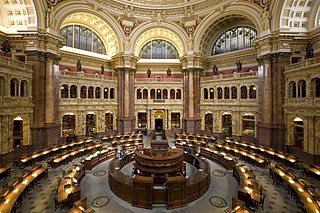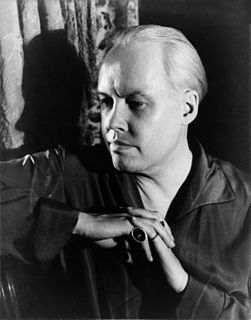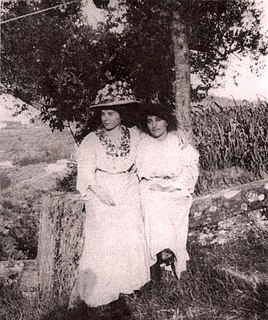 First edition | |
| Author | Gertrude Stein |
|---|---|
| Publisher | Random House |
Publication date | 15 February 1941 |
| Pages | 154 |
| Preceded by | Paris France (1940) |
| Followed by | Wars I Have Seen (1945) |
Ida A Novel is a novel by Gertrude Stein, first published in 1941.
 First edition | |
| Author | Gertrude Stein |
|---|---|
| Publisher | Random House |
Publication date | 15 February 1941 |
| Pages | 154 |
| Preceded by | Paris France (1940) |
| Followed by | Wars I Have Seen (1945) |
Ida A Novel is a novel by Gertrude Stein, first published in 1941.
Following Ida from her birth into adulthood, the narrative describes her relationships with dogs, encounters with strangers, and her multiple marriages, probably five. (Many details of her life are left unstated.) The novel is structured in two halves, the first in six parts, and the second in eight parts. She moves around the United States, and in the latter part of the novel she may be living in Europe. As a young woman Ida becomes well known and therefore must constantly negotiate people's perceptions of her; her common response is to escape. When people try to find her she is often elsewhere.
Stein said that the novel was "about publicity saints. The idea of the book is that religion has been replaced by publicity. A 'publicity saint' [...] is a saint with a certain mystical something about him which keeps him a saint; he does nothing and says nothing, and nobody is affected by him in any way whatsoever." [1] With the phrase "publicity saint" Stein was thinking about people who, because the media follow them obsessively, become famous for being famous. Their lives as famous people interest us more than what they might actually do. Among the models Stein used was the Duchess of Windsor.
The narrator of Ida depicts a woman with a divided self: a part of her seems under the control of others, men especially, but there is another part that resists. We can never really be sure we know who Ida is. Stein's friend W. G. Rogers noted that "there is a definite one-sex-against-the-other conflict in it, that hasn't been in your books ever before." [2]
Stein began writing Ida in May 1937, shortly after finishing her second autobiography, Everybody's Autobiography . Through the rest of 1937 she tried, unsuccessfully, to interest Thornton Wilder, a close friend at the time, in a collaboration on the novel. Stein worked on the first half of the novel until early 1940, rewriting it twice, and wrote the second half in April–May 1940. The manuscripts are in the Beinecke Rare Book and Manuscript Library. While working on Ida Stein also wrote Picasso (1937), Doctor Faustus Lights the Lights (1938), The World Is Round (1938), and Paris France (1939).

Edith Stein was a German Jewish philosopher who converted to Christianity and became a Discalced Carmelite nun. She is canonized as a martyr and saint of the Catholic Church; she is also one of six patron saints of Europe.

Thornton Niven Wilder was an American playwright and novelist. He won three Pulitzer Prizes — for the novel The Bridge of San Luis Rey and for the plays Our Town and The Skin of Our Teeth — and a U.S. National Book Award for the novel The Eighth Day.

Gertrude Stein was an American novelist, poet, playwright, and art collector. Born in Pittsburgh, Pennsylvania, in the Allegheny West neighborhood and raised in Oakland, California, Stein moved to Paris in 1903, and made France her home for the remainder of her life. She hosted a Paris salon, where the leading figures of modernism in literature and art, such as Pablo Picasso, Ernest Hemingway, F. Scott Fitzgerald, Sinclair Lewis, Ezra Pound, Sherwood Anderson and Henri Matisse, would meet.

Gabrielle Roy was a Canadian author from St. Boniface, Manitoba and one of the major figures in French Canadian literature.

Alice Babette Toklas was an American-born member of the Parisian avant-garde of the early 20th century, and the life partner of American writer Gertrude Stein.

Jorge Agustín Nicolás Ruiz de Santayana y Borrás, known in English as George Santayana, was a philosopher, essayist, poet, and novelist. Born in Spain, Santayana was raised and educated in the US from the age of eight and identified himself as an American, although he always retained a valid Spanish passport. At the age of 48, Santayana left his position at Harvard and returned to Europe permanently.

American literature is literature written or produced in the United States of America and in the colonies that preceded it. The American literary tradition thus is part of the broader tradition of English-language literature, but also includes literature of other traditions produced in the United States and in other immigrant languages. Furthermore, a rich tradition of oral storytelling exists amongst Native American tribes.

Susan Howe is an American poet, scholar, essayist and critic, who has been closely associated with the Language poets, among other poetry movements. Her work is often classified as Postmodern because it expands traditional notions of genre. Many of Howe's books are layered with historical, mythical, and other references, often presented in an unorthodox format. Her work contains lyrical echoes of sound, and yet is not pinned down by a consistent metrical pattern or a conventional poetic rhyme scheme.

Carl Van Vechten was an American writer and artistic photographer who was a patron of the Harlem Renaissance and the literary executor of Gertrude Stein. He gained fame as a writer, and notoriety as well, for his 1926 novel Nigger Heaven. In his later years, he took up photography and took many portraits of notable people. Although he was married to women for most of his adult life, Van Vechten engaged in numerous homosexual affairs over his lifetime.

The Autobiography of Alice B. Toklas is a book by Gertrude Stein, written in October and November 1932 and published in 1933. It employs the form of an autobiography authored by Alice B. Toklas, her life partner. In 1998, Modern Library ranked it as one of the 20 greatest English-language nonfiction books of the 20th century.
Four Saints in Three Acts is an opera composed in 1928 by Virgil Thomson, setting a libretto written in 1927 by Gertrude Stein. It contains about 20 saints and is in at least four acts. It was groundbreaking in form, content, and for its all-black cast, with singers directed by Eva Jessye, a prominent black choral director, and supported by her choir.
Eva Hoffman is an internationally acclaimed, award-winning writer and academic.
Barbara Ellen Johnson was an American literary critic and translator, born in Boston. She was a Professor of English and Comparative Literature and the Fredric Wertham Professor of Law and Psychiatry in Society at Harvard University. Her scholarship incorporated a variety of structuralist and poststructuralist perspectives—including deconstruction, Lacanian psychoanalysis, and feminist theory—into a critical, interdisciplinary study of literature. As a scholar, teacher, and translator, Johnson helped make the theories of French philosopher Jacques Derrida accessible to English-speaking audiences in the United States at a time when they had just begun to gain recognition in France. Accordingly, she is often associated with the "Yale School" of academic literary criticism.

Giannina Braschi is a Puerto Rican poet, novelist, dramatist, and scholar. Her notable works include Empire of Dreams (1988), Yo-Yo Boing! (1998) and United States of Banana (2011).
Doctor Faustus Lights the Lights (1938) is a libretto for an opera by the American modernist playwright and poet Gertrude Stein. The text has become a rite of passage for avant-garde theatre artists from the United States: La MaMa Experimental Theatre Club, Judson Poets' Group, The Living Theatre, Richard Foreman, Robert Wilson, The Wooster Group, and Production Workshop at Brown University have all produced the piece.

Harriet Lane Levy is a California writer best known for her memoir, 920 O’Farrell Street. Levy was also an avid art collector, a girlhood friend of Alice B. Toklas, and an acquaintance of Gertrude Stein.
Linda Lappin is an American poet, novelist, and translator.

Harriet Scott Chessman is an American author of four novels, including Lydia Cassatt Reading the Morning Paper, a #1 Booksense Pick, Someone Not Really Her Mother, a Good Morning America book club choice, and The Beauty of Ordinary Things. Chessman's subjects often center on mortality, love, trauma, and the restorative power of art.
Empire of Dreams is a postmodern poetry epic by Puerto Rican author Giannina Braschi, who is considered "one of the most revolutionary voices in Latin American literature today".
Ulla E. Dydo was a Swiss-born writer, editor and noted Gertrude Stein scholar. She was Professor Emerita at the City University of New York and author of Gertrude Stein: The Language That Rises, 1923–1934.